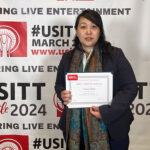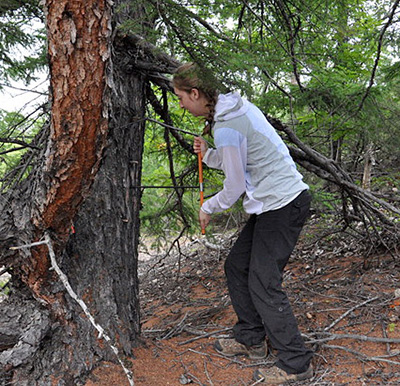
Recent Grads Published in Scientific Journal Following Fieldwork, Data Analysis in Eastern Russia

WOOSTER, Ohio – Two recent College of Wooster graduates – Clara Deck ’17 and Sarah Frederick ’15, both geology majors – were recently published in Forests, a monthly journal of forestry and forest ecology, for their investigation as undergraduates on how forests in eastern Russia are responding to climate change.
The article, titled “Elevational Transect and Hemisphere-Wide Comparisons, Kamchatka Peninsula, Russian Far East,” details historical temperature and precipitation data that was collected by coring for tree-ring widths of birch and larch species in an area that is noted for a wide range of elevations. The information, and subsequent analysis, leads to a greater understanding of the North Pacific coastal region’s warming and the response of its forests.
Under the guidance of Greg Wiles, professor of geology, Deck and Frederick had two complementary roles in the publication, Frederick performing quite a bit of the fieldwork, meticulously taking straw-size samples of 500 or so trees, and Deck measuring individual tree rings in the lab at Wooster, then analyzing the tree rings for their climate signal.
Frederick looks back on her fieldwork, which took place in July 2014, as a career-altering experience that has led to her current work at the Laboratory of Tree-Ring Research at the University of Arizona, where she is pursuing a master’s degree. “It was amazing … and very influential for me. Most undergrads don’t have the opportunity to do international field research. I found a niche that I really enjoyed doing. I’m really grateful that’s something Wooster can offer students. At a lot of schools, it would have been the graduate students doing that work,” she said.
In the lab, it was an equally valuable experience for Deck, who studied permafrost in Alaska for her Independent Study. With Wiles navigating her through the grunt work that resulted in this publication, she gained an appreciation for the “long and laborious process” of being able to date the trees and measuring how much they grew each year by the width of each ring.
“In the case of these trees in Russia, we found that they’re ring width was directly correlated to summer temperature. It’s a helpful tool to see back into the (past) to see what’s going on with the climate,” remarked Deck, who is listed as the first author of the paper and now in the earth and climate sciences master’s program at the University of Maine, studying ice sheet stability.
Frederick also noted that an extensive network of tree-ring records existed in Alaska, Japan, and other nearby areas, but there were few in far eastern Russia. “The goal of this project was to fill in a large data gap in understanding temperature primarily, but also larger dynamics in the northern Pacific, which I think was done fairly successfully,” she said.
Joining Deck, Frederick, and Wiles as authors on the project were three Russian geologists, who were vital in locating the right sites for the fieldwork as well as interpreting the data. Rosanne D’Arrigo, a tree-ring researcher at Columbia University’s Lamont-Doherty Earth Observatory, and Nick Wiesenberg, Wooster’s geological technician, were also co-authors.
Wiles added that further collaboration among Wooster, Lamont, and the Russians will continue, and that the data set Frederick, Deck, and their colleagues collected in Russia is archived in the International Tree Ring Databank, a resource for climate scientists interested in climate and ecological research.
Image: Sarah Frederick ’15, pictured here coring trees in eastern Russia, was part of a Wooster-led publication that collected tree-ring data and analyzed how forests are responding to climate change.
Posted in News on November 20, 2017.
Related Posts
Related Areas of Study
Geology
Start research in your first year and graduate with a strong foundation in the Earth Sciences.
Major Minor

